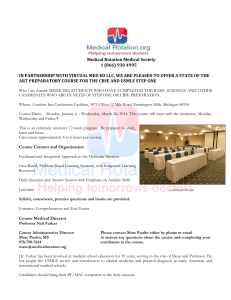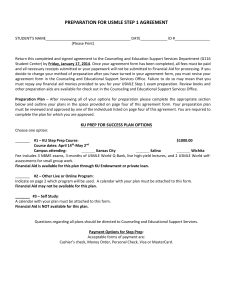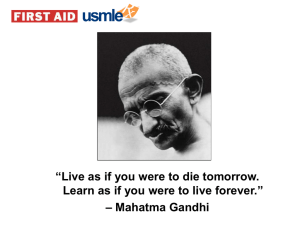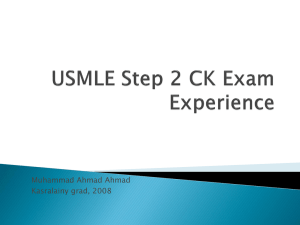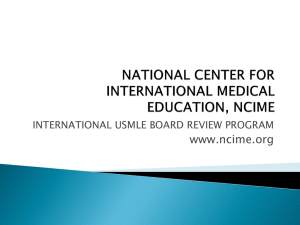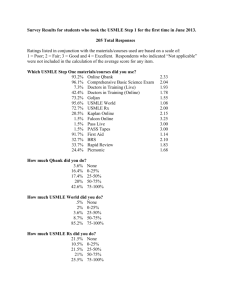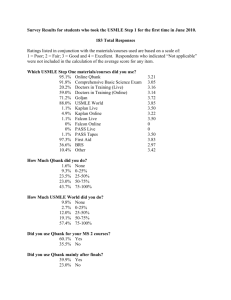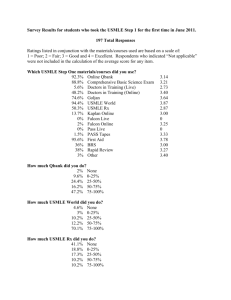Handbook of USMLE Step 1 Edition
advertisement
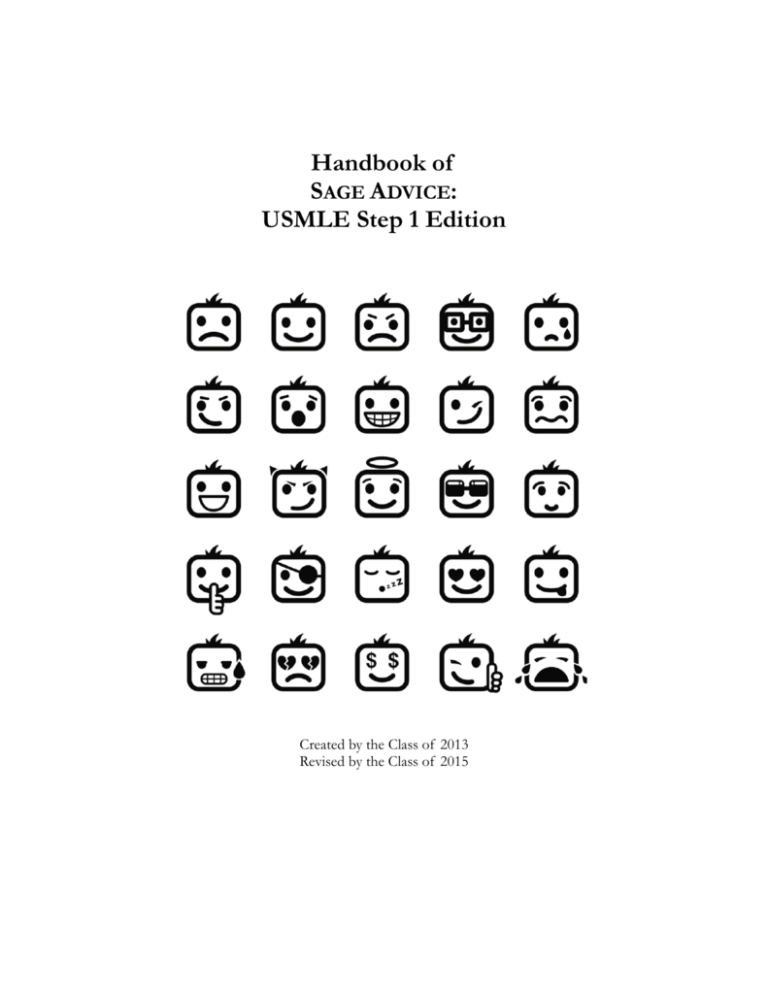
Handbook of SAGE ADVICE: USMLE Step 1 Edition Created by the Class of 2013 Revised by the Class of 2015 2 TABLE OF CONTENTS Quick Reference Guide – pg. 4 Resources and References – pg. 5 The Mock Board – pg. 7 Studying: When to Start and How to Study – pg. 7 Days Prior to the Exam – pg. 9 Test Day Logistics – pg. 10 Miscellaneous Step 1 Advice – pg. 12 Who Can I Contact for Advice or Example Schedules? – pg. 12 What to Do if You Don’t Pass – pg. 13 3 QUICK REFERENCE GUIDE The Official USMLE Website • www.usmle.org National Board of Medical Examiners (NBME) • http://www.nbme.org/ • Register for the boards via this website: https://apps.nbme.org/ciw2/prod/jsp/login.jsp • Purchase self-assessments (Clinical Basic Science Self-Assessments), which are online equivalents to the mock-board administered by OHSU in spring o These are very useful, because scores correlate very well with actual Step 1 performance (Acad Med. 2010;85:S98–S101) o https://nsas.nbme.org/nsasweb/servlet/mesa_main Prometrix • Register for your test date and location at this website: http://www.prometric.com/USMLE/step1 Dean’s Office & Dr. O’s USMLE Page • Kaitlin Seymore, Executive Assistant to Dr. Molly Osborne: 503-494-0807 or 503-494-8228 • Dr. O’s USMLE page- includes Step 1 resources, link to the Michael Wilson videos, on campus contacts for studying success: http://www.ohsu.edu/xd/education/schools/school-ofmedicine/academic-programs/md-program/student-affairs/usmle-exams.cfm OHSU Library • List of resources/prep books available for checkout: http://www.ohsu.edu/xd/education/library/upload/USMLE_PrepResources.pdf • FREE USMLEasy Q bank access: http://www.ohsu.edu/xd/education/library/about/whats-new/usmleasy-trial.cfm?WT_rank=3 Michael Wilson • FREE online subject-based video lectures and handouts taught by a former OHSU med student • Includes 28 different videos on subjects such as Biochemistry, Embryology, Immunology, Pharmacology, GI, Microbiology, Neurology, Endocrinology, Pulmonology, CT Vasculitis, etc. • Access from Dr. O’s USMLE site: http://www.ohsu.edu/xd/education/schools/school-ofmedicine/academic-programs/md-program/student-affairs/usmle-exams.cfm o Click on “Michael Wilson’s USMLE Video Preparation Guide” o Username & password are the same as OHSU email login Learning Strategies • Shelby Acteson, OHSU Office of Student Access (OSA), Mackenzie Hall 1115 • 503-494-0082, actesons@ohsu.edu Student Health Services • 503-494-8665 • If you are feeling anxious or overwhelmed, you are not alone and Student Health Services has been working with students for years to help them work through this time successfully and confidentially. 4 RESOURCES AND REFERENCES Using First Aid and at least one Qbank is essential. Many people use either the Pathoma program (video lectures and/or book) or Goljan (lectures and/or review book) to supplement First Aid for pathology. The back of First Aid contains a litany of other materials you might consider purchasing based on your own needs. It is better to have a few key resources and cover them in depth, than to have several resources and only cover them partially. There are several other review courses offered such as Kaplan and Doctors in Training (DIT). These are good for students who want a ready-made approach to covering the wealth of material. They both have daily video lectures that serve as the bulk of your review and have review questions throughout the lectures to check for understanding. Some students find the review questions, pauses for diagrams/writing out pathways, etc. to be helpful in keeping the learning a more active process through the long hours. Kaplan offers one of the most-used Qbanks as well. If you use DIT, which is significantly less expensive than the Kaplan review course, you will still need to get a Qbank as it does not include USMLE-style questions. Suggestions for using First Aid: • As an MS2, follow along in First Aid with your courses so that you are comfortable with the information it covers. It has helpful summary diagrams for solidifying course material and you’ll be more familiar with the material come May. • Buy the newest edition of FA when it is released in Dec/Jan, as there are year-to-year variations and the notes you made early in first/second year will likely not apply to the USMLE-style questions. • Consider having the FA book 3-ring punched and placed in a binder so you can add valuable selfmade study guides or high-yield sheets from other resources. This will make it easy to remove sections at a time for quick study (at the gym, while following along during class) without carrying a large book. • Correct errors, as there are sure to be MANY. Errata will be posted here: http://www.firstaidteam.com/updates-and-corrections • A good goal is to have at least skimmed First Aid once or twice before the study period. Repetition makes for the best familiarity with its contents! • The best annotations are those that will help you distinguish between right and wrong USMLE answers. Some students find it helpful to follow along and annotate in First Aid when reviewing answers to Qbank questions. This achieves two goals: 1) reviewing corresponding content in FA relevant to the QBank questions 2) documenting the question/explanation in FA for review during future passes through FA. Other high-yield annotations include the blue-colored margin notes from Rapid Review Pathology and RR Biochemistry. It may be helpful to use different colored pens for annotations from different Qbanks or other sources (ex: blue for U-World, red for Kaplan). Commonly Used Online Resources: (in no particular order) • QBanks: USMLE World (U-World), USMLE Rx, Kaplan, USMLEasy (free from the library) • Content Review Programs: Doctors in Training (DIT), Pathoma, Goljan, Kaplan • Planning a Study Schedule: Cram Fighters App • Practice Exams: NBME CBSSAs, Kaplan, USMLE World • Flash Cards: USMLE Rx First Aid Flash Facts, StudyBlue App 5 Topic Specific Recommendations: The best way to assess your strengths/weaknesses is to take practice questions and see if your level of understanding matches the style in which USMLE questions are written. Below are some helpful resources from students in years past if you are looking for supplementary materials for specific subjects in which you need extra assistance. That being said, as stated before it is best to concentrate on a few materials and cover them thoroughly rather than to have a pile of books. Do NOT get each of these resources for each subject- it’s simply too much! • • • • • • Biochemistry is very important for the USMLE Step 1. Vitamin-oriented questions are all over the exam. Even if you did not do well in CSF, you can master this material as a second year! In fact, it may make more sense as you tie in the clinical relevance with basic science. If you consider biochem a weakness, here is a great way to tackle the subject matter: 1. Watch Mike Wilson’s online lectures and follow along with the worksheets 2. Redraw Mike Wilson’s Biochem Love Sheet 3. Buy and review Rapid Review Biochemistry by Pelley (see below) AND do all of the online questions with this book Outline format designed for the boards (vs CSF) & shorter read than Lippincotts Free corresponding online questions (~350) are a great way to test concepts Everything is tied to clinical relevance, making it easier to appreciate Key points are highlighted in the margins for quick review Behavioral Science: FA and Mike Wilson cover biostats wonderfully. If you need more help with ethics questions, Kaplan’s Review Book has a few good charts with general rules regarding physician-patient relationships and ethical/legal issues. Anatomy & Embryology are covered in First Aid, QBanks, and review courses (DIT, Kaplan). There isn’t a section specific to anatomy, but it is somewhat low yield to spend a lot of time reviewing outside resources. Microbiology & Immunology are very well covered in FA. Mike Wilson is another great resource for micro. Microcards by Sanjiv Harpavat are great for partner/self quizzing. And, if you are a visual learner, Garland Science (via YouTube) has excellent, short video depictions of T and B cell maturation. http://www.youtube.com/user/garlandscience. Pathology is not well covered in FA. Rapid Review Patholog y by Goljan , the Goljan audio files , or the Pathoma program are other good ways to cover this material. That being said, many students didn’t use these programs and did just fine. The NBME self-assessment tests have many questions with pictures/slides that are a helpful representation of questions from the actual exam. Pharmacology is great to review over and over and over throughout the year. 1. Start by mastering the pharm at the end of each chapter in FA. The Toxins & Antidotes Do LOTS of practice questions. Use flash cards to quiz with friends. Lange Pharmacolog y Flash Cards are the best of ALL the flashcards. Each card has a clinical vignette on the front, making them great for solo/partner quizzing. Concise, pertinent info on the back and much more condensed than many other cards. Lacks a few drugs, but hits all the major ones. Cardiovascular, Endocrine… and the rest of the system-based topics are best covered in FA. BRS physiolog y is the next best resource if you are weak in one of these, and it offers a concise outline format and helpful diagrams. There will be audio questions on the exam for heart murmurs and any good QBank will have examples of these. The NBME tutorial has examples of these questions which are highly recommended to practice! 2. 3. • 6 and Drug Reactions sections of FA are some of the highest yield pages of FA. • When students are asked what resource was NOT helpful for them for Boards study, the most common answer is class notes. Self-Assessments & Score “Predictors”: Take the NBME CBSSA (Comprehensive Basic Science SelfAssessment) practice exams! https://nsas.nbme.org/nsasweb/servlet/mesa_main • Take these as if you are taking the real exam: timed and completed in one sitting. • Each costs ~$50 ($60 with “expanded feedback”), takes ~4 hours, and is accessible for 30 days after purchase. • They are non-refundable. • Feedback is immediate with regard to stronger/weaker areas of performance; however, you will not be given the answers and explanations to questions (even if you pay the extra $10 for the “expanded feedback”). If you are really curious about the answers to specific questions, these are usually welldiscussed on forums such as Student Doctor Network (but beware, these are not true answer keys and can be stressful to read!). • If you’re debating whether to pay for these practice exams, there’s a paper in Academic Medicine that looks at the relationship between the NBME exam and Step 1. People who do more NBME exams did better on the real exam, and the relationship between mock and real scores is pretty good (R2=0.67). More than that, they help you get a feel for “real exam” material compared with the Qbank questions you’re using—these mock exams are written by the same people who create Step 1! • About Qbank scoring: don’t worry if you get more Qbank questions wrong than correct! The questions are designed to be difficult so that you will learn from them. You’ll be amazed how well you remember content because you got the question wrong. Beware of online “score predictors” using Qbank percentages- they’re not official and are likely to stress you out. THE MOCK BOARD This is a four-hour exam written by the NBME and administered by TSO staff on a Thursday or Friday in early March. Most people have not prepared going in to this exam. It can serve as a good baseline of strong and weak areas. For the vast majority of students, it’s a reality check and should get everyone in study mode. Most people will feel pressure to increase their USMLE study after receiving the results. If you begin to feel overwhelmed, don’t hesitate to speak with a counselor or someone at Student Health early so that they can help you work through the pressure and be more productive. It takes approximately one month to get the results. Minimum Passing Score for USMLE Step 1 is 188. STUDYING: WHEN TO START AND HOW TO STUDY When to Start Studying & How to Budget Your Time: As you might guess, this varies from individual to individual. • Some students start reviewing in December/January; others start around Spring Break or closer to the study period – there is no right way. • Enjoy your winter break! • Whenever you choose to start reviewing, get organized and be realistic with your goals. • A reasonable goal for some people is to do 5-10 Qbank questions per day on non-exam weeks. • At the latest, get everything organized by Spring Break. 7 • You have a total of five weeks of dedicated study time after the conclusion of 2nd year. Make a goal of what you would like to accomplish during that time (i.e., review FA one, two, or three times, start and complete a whole QBank vs. finish a QBank, take a vacation after boards, etc.). Ask yourself how many hours you can realistically study in one day and over the course of weeks without burning out. Determine whether you need a day off each week to recoup or if you have any important functions to attend. Then, schedule your test date around these goals. The ultimate goal is to study once, pass and/or crush the boards, and move on. How to Study: • Outline your goals (USMLE score, what you’d like to cover prior to the study period) in December/January. Set reasonable goals and give yourself flexibility/catch up time to ensure that you meet your goals (i.e., 1 hour per day during non-exam weeks, # of questions to cover prior to the study period, first pass through FA, etc.). It’s okay if you don’t study every day or don’t meet your weekly goals prior to the study period, but having goals is a great motivator. • Select your review material(s). A general recommendation is to review First Aid simultaneously with your corresponding courses throughout second year. Annotate in FA, but make sure to purchase the new edition in December, as there are changes every year. • DO QUESTIONS! This is the number one learning tool for the USMLE Step 1 and all future board exams. It seems counter-intuitive to do questions prior to studying, but it really will allow you to become familiar with 1) how questions are asked 2) what you are expected to know 3) where you perform strongly/weakly. And you will be shocked how well you tend to remember information after getting a question wrong (or right) it. Aim to complete AT LEAST one QBank (~2,000 Qs). If you finish one QBank, consider repeating incorrect questions until you’ve “perfected” them all, or purchase a second QBank. There is no such thing as too many questions, but REVIEWING AND UNDERSTANDING the answers to questions is more important than going through more questions quickly. It takes twice as long to review questions as it does to take them, so budget your time wisely! • Take self-assessments or full-length practice exams. The first one will be the Mock Board. Then, it is useful to take at least one (NBME or from a QBank - see resource guide) about halfway through your study period. This will tell you whether or not you are on track to pass and it will help you develop your ability to take a LONG test – which is different from knowing the material. The exhaustion you feel at the end of these long days should not be dismissed. The real exam day will also be exhausting, but learning to be resilient and to not dwell on single questions for too long is also critical. There is no magic number of tests that you should take; just remember that it is equally important to be able to answer questions for seven hours as it is to know the secondary messengers in cell signaling cascades. To Study Alone… or To Study with Classmates: Again, this varies for every individual. If you studied alone throughout first and second year AND are happy with this style AND are happy with your scores to date, you likely study best alone and should primarily stick with this method. The converse applies if you studied with a partner/group. If you are not happy with your study habits to date, try addressing them early in the year to see if another style works better for you. Regardless of whether you study with/without someone, it also is important to keep human contact and have someone who can let you vent your anxieties. If you’re studying alone, consider studying in a location where you will have this opportunity. 8 • • Advantages/Disadvantages of studying solo: Goals are individualized and you can cover topics you know well quickly while spending time on personal tough spots. Avoidance of others that may stress you out. But, you must be self-motivated. Advantages/Disadvantage of studying with a partner (or group): Opportunity to quiz/teach each other material. It is helpful to have someone with whom you can cross check your understanding of material and challenge one another. Having a partner also motivates you to set goals/schedules together. Studying with a classmate or having a family member quiz you can pump you up, help you focus, and bring you back to reality. However, by focusing on a partner’s/group’s needs, you might spend time on topics you know well or miss topics that you don’t understand. And, you might get stressed if surrounded by your peers. Study Schedules: A study schedule is important for many reasons. This schedule should be a written plan that describes the activities of each and every day between the last day of the Blood course and the day of the exam. Reasons to create a study schedule include: 1. It minimizes the amount of extraneous thinking you need to do during your study month. By having an idea of what each day will look like, it helps to make efficient use of your time and to wake up each day with a focused goal. It also makes you feel okay that you are taking time off every now and then, because if you don’t schedule it, you will be too stressed to enjoy any breaks you take. 2. It gives you a sense of accomplishment. Crossing off days on a schedule indicates you are making progress. 3. It helps you to budget time. You can create your own schedule based on your goals and what you have to accomplish. Or, you can take other students examples and edit them. Another resource available to help make a schedule is the Cram Fighters App which is $10, but comes highly recommended and “well worth the money” from participating students. If you wish to make a custom schedule, here is a reasonable approach: o Set your goals for the study period. o Calculate how many days are in the study period and divide your goals among the days. o Break up study time with question and review time. o Plan to study 8-10 hours per day (+/- depending on progress) o Make adequate time to review questions. It often takes twice as long to review questions as it does to answer them. This is one of the most important points of the study period, as the explanations (particularly with USMLEWorld) help you to understand the reasoning behind each correct/incorrect option. o Plan ½-1 full day per week of “catch up” time. This will allow you to make up work if you didn’t meet your weekly goals or do some extra practice questions. o Take a self-assessment (NBME CBSSA, see resource guide) half-way through your study period. If you are not meeting your goals, address your weak areas and take another self-assessment in one week. DAYS PRIOR TO THE EXAM One week: Have the bulk of your studying done by 1 week prior to your exam. You don’t want to add stress to this week by having areas that you haven’t covered yet. • Continue doing questions in your QBank and going over them. (25-50 questions/night) • Make one final pass through First Aid over 4-5 days: try to break it up into even blocks but remember that some of the sections can be pretty dense; especially biochem, micro, and 9 • • • neuro. Look over your notes, go over diagrams, and make sure that the especially high yield info is solid. Do a trial run to make sure you know where your test center is. Do the NBME free exam tutorial. This is the same tutorial about using the exam software as you will get at the beginning of the exam along with ~100 free exam questions. Highly recommended! Gives you extra break time during the exam time and the questions are free! Get lots of rest this week! You may not sleep well the night before the exam, but that’s okay. One day: • Eat a good breakfast, exercise, relax. • Go over the Rapid Review at the back of First Aid. Go over flash cards or any areas that you feel weak in but don’t overdo it. • Go over the topics you would like to write on your notes sheet for during the exam (see more in Test Day Logistics section). • Don’t study more than 4-6 hours or don’t study at all. TEST DAY LOGISTICS The night before your test: Find your scheduling permit, ID and lunch. Double-check your alarm clockset multiple alarms. Make sure you have comfortable clothes for sitting all day and layers in case you get chilly—no big coats allowed in the test room. What to bring: Your scheduling permit that you print from the internet and two forms of identification that contain a recent picture and a signature (driver’s license and passport for example). Getting there: Go for a trial drive-by (or bus or bike) so you know how to find the testing center. There are two in Portland, so make sure you know which is yours. Consider traffic! Before the test: You sign up as you arrive and they call your name to get fingerprints and take your permit. What goes in your mini-locker: You can store food, water, keys, phone, watch, coats, hats and anything else you need on breaks. You can bring study materials but those aren’t allowed near the test room. Keep in mind that this is a small locker (it won’t fit a large backpack). You may want to consider bringing lubricant eye drops, Ibuprofen in case of a headache- it’s a lot of screen time! What goes in the test room: You, empty pockets, earplugs that are out of the box. You really can’t bring anything into the testing room except the clothes on your back. You can’t have anything on your head! Not a hat, a hood or an oversized hairpiece – the monitors have to be able to see your head at all times. Some students recommend wearing as few pockets as possible as you will have to turn out your pockets with each re-entry into the exam room. The center provides you with a headset (for any cardio murmurs), dry erase paper, marker and eraser. Also, no jewelry or watches are allowed. There will be a clock on the computer to keep track of your time (the interface is very similar to USMLEWorld). Lastly, you will write your permit number on the paper and use it to sign on to your computer after breaks. The test: The test administrator turns on your screen and the computer gives you the rest of your instructions. You can do the tutorial at your computer at home to add time to your official test-day break time. Do it! If you get to test day and want to click through things again, you can also use the time to collect your thoughts and take deep breaths. There are 7 one-hour blocks. They tend to blur together but 10 just get into your rhythm and go with it. Take your breaks just as a chance to walk around for a little bit— even if it is just to the bathroom and back. Speaking of breaks… Breaks: YOU ARE IN CHARGE OF MANAGING YOUR BREAK TIME. You have a given amount of time for the whole day (45 minutes +/- tutorial time), so budget how much time you’d like for each break and lunch. The computer will tell you when your time for a block is up and then a countdown of break time remaining appears. The break-time screen has to be up before you can leave your computer. You will have to give your electronic fingerprint EACH AND EVERY TIME you leave and enter the test room. Take a walk around the building, stretch and eat during breaks. You are allowed to use your phone if you aren’t talking about test-y matters or participating in ‘unauthorized assistance.’ Remember that it can take several minutes to get back into the testing room since you have to do the fingerprint and pocket check- especially if there are several students taking a break at the same time- so don’t get caught running out of time. Lunch: Bring your lunch and keep it simple. There isn’t a microwave or anything like that available. The center might have a water cooler. You may want to pack a tasty meal or exciting snacks so that you have something enjoyable to consume during the long day. Notes Sheet: You will be provided 2 laminated sheets at the beginning of the exam on which to jot notes and work during the exam (these stay at your exam desk). These are front and back sheets- you can ask for more if you cover both of the provided sheets. Some students find the sheet space useful for writing down formulas at the beginning of the exam for quick access throughout the day- for example the epidemiology 2x2, equations, or lung volumes diagram. You may want to plan out ahead of time which topics you would like on your sheet and practice them the day before the exam so you’re ready to go. Dress rehearsal (optional): You can register for a practice test at your center for $52 and take a shorter, no-pressure version of the big kahuna. These exams are the same as the NBME self-assessment, so be sure to take one you haven’t done yet. The software is close, but not identical to the real thing (see resources for more info on the NBME Self-Assessments), and they give you a score upon completion. Taking a practice exam at the testing center allows you to become familiar with the test site and to ask any questions prior to the real test day. Keep in mind that others may be taking their exam, so you need to be courteous! This is an optional experience and many people don’t take this opportunity but still perform splendidly on the exam and have fifty extra dollars for post-exam fun! To schedule a practice exam, go to: https://apps.nbme.org/CBTPSRegistrationWeb/jsp/usmle_CBTPS_registration.jsp Official statements/Rules: http://www.usmle.org/bulletin/testing/ Special Accommodations: If you need these, start planning early and talk to the Dean’s office about making arrangements. http://www.usmle.org/test-accommodations/ Test Day Woes: During the exam itself, many students experience feelings of panic, stress, and lack of confidence in their answers. Even some of the highest Step 1 scorers have stated that they thought they were failing the exam due to uncertainty about so many questions. You are not doing as poorly as you think you are! Remember that some of the questions are thrown in for research purposes only- your response on those questions does not count towards your score. Anticipate the fact that this is not going to be an easy experience, but figure out what works best for you to overcome these moments of anxiety. Take some deep breaths or close your eyes for a few seconds to re-center your focus, and get to it! You can, and you will do great!!! 11 MISCELLANEOUS STEP 1 ADVICE We all hate to discuss our vulnerability, but the truth is that this is a stressful time for most, if not everyone, preparing for the exam. Help is available – either from peers in the classes ahead of you, from the Dean’s Office, or from Student Health. “I’m glad that I dealt with stress early on [in December] by recognizing my increasing level of stress and anxiety, and how this was beginning to impact my performance in all aspects of life. I’m glad I decided to consult my physician in Student Health about these issues and felt that I was better able to tackle the exam when June rolled around.” –Med13 student “We believe in you!!!!!” –Med15 “Use First Aid. Don’t spend too much time sorting through different types of study guides. Aim for enough time to go through 2 good sources twice instead of 4 sources.” –Med15 student “Learn as much as you can from all of your courses…even PCM! I can’t tell you how useful it was to have a good grasp of biostats, ethics, screening tests, and physical exam maneuvers on Step 1. Definitely try to take away as much as you can. I also found it was helpful to quickly skim over the relevant parts of First Aid before a test just to compare and contrast. It was a nice way to build in a “first time pass” through First Aid without adding too much stress/time to my workload for class. Definitely don’t try to memorize anything before study period; you won’t remember the details anyway. Do some practice questions throughout the year. Don’t be too hard on yourself about this. I just did USMLEasy questions through the library for most of the year. I started out doing 5 questions per night without taking notes or anything. Overall, I found that focusing on learning in class (the best prep you can do!), not obsessing too much about Step 1 (and what everyone else is doing!), and dedicating 1-2 hours of my weekend to reading/questions was plenty of preparation during the year.” –Med15 student “Practice how you are going to play (i.e. do LOTS of practice questions).” –Med15 student “Don’t take advice from anyone unless they are willing to tell you their score.” –Med14 student “Don’t force study materials that aren’t working. Count it as a financial loss and move on. It’s not worth lost time.” –Med15 student “Work hard and you will do well.” –Med15 student “Have fun!” –Med15 student WHO CAN I CONTACT FOR ADVICE OR EXAMPLE SCHEDULES? These gracious Med15 students have offered to be contacted for questions in the areas below. Planning a Study Schedule: Bethany Laubacher, Devin Lee, Kevin Kolahi, Tanya Widmer, Susan Lou Individual Study: Devin Lee, Bianca Argueza, Carolyn Foley, Mario Padilla, Kevin Kolahi Group or Partner Study: Michelle DeChant Study-Family Life Balance: Mario Padilla, Stephanie Laudert, Devin Lee, Michelle DeChant DIT: Tanya Widmer, Campbell Cross, Carolyn Foley, Amy Anderton, Bethany Laubacher Pathoma: Carolyn Foley, Campbell Cross, Susan Lou Kaplan: Kevin Kolahi Goljan: Kevin Kolahi Self-Made Study Plan: Bianca Argueza, Kevin Kolahi, Michelle DeChant 12 WHAT TO DO IF YOU DON’T PASS Requirements: Students are required to take and record a passing score for USMLE Step I prior to entering the third year clerkship year. All Students must take the exam prior to starting the Transition to Clerkship course. MD/PhD and MD/MPH students are required to take and pass the USMLE Step I prior to being eligible to enter graduate studies or clinical curriculum. Steps After Notification of Non-passing Score: Students who receive a non-passing score may complete their current clerkship rotation or take an incomplete. When the EdSA office is notified of a non-passing grade the student will be put on a Leave of Absence which will begin the first day of the next rotation. They will be given an automatic six month leave of absence to achieve a passing score on Step I and must pass the exam before they can reenter the clinical curriculum. It is recommended that the student take the exam within six to seven weeks of the start of the LOA. This allows approximately three weeks for the score to be calculated and sent to the EdSA office. If a student does take the exam within six or seven weeks of the start of the LOA, it will allow them to finish in four years, and not take an extension. The student will have a very tight fourth year schedule, but will be able to finish with their matriculating class. When the Director of Student Records is informed of the non-passing grade, the Director will vacate the students’ third year schedule, and notify the clerkships that the student has been pulled from the upcoming clerkships. When the Director of Student Records has been informed of the passing grade, the student will then request a time to meet with the Director to create a new third year schedule. During this leave time, students can decide to be registered for the Basic Science Review Course for a maximum of two terms to remediate USMLE Step I or Step II CK/CS. The student must be registered for an approved board study course to be eligible to be registered for the Basic Science Review Course JCON 602A. Credits from this course do NOT count towards fulfilling graduation requirements. Students must seek approval from the Associate Dean for Student Affairs prior to registration. If they do not pass USMLE Step I within that year, they will be subject to a dismissal hearing by the Student Progress Board. If a student wishes to reenter the curriculum before the one-year leave of absence is completed, the student must make the request in writing prior to the start of the next clerkship. 13

